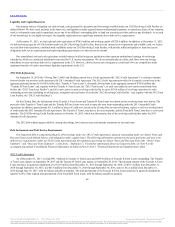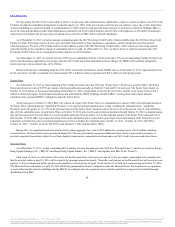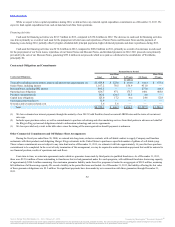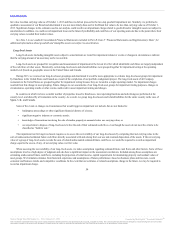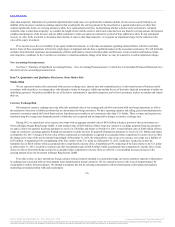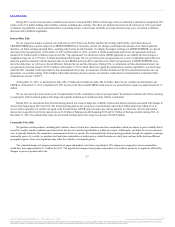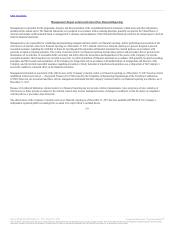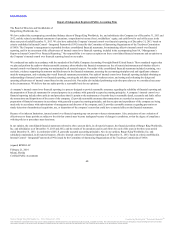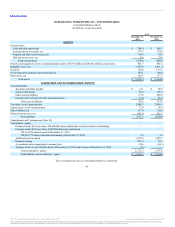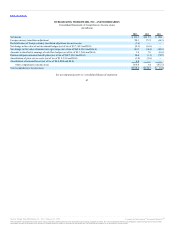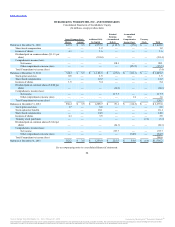Burger King 2013 Annual Report Download - page 56
Download and view the complete annual report
Please find page 56 of the 2013 Burger King annual report below. You can navigate through the pages in the report by either clicking on the pages listed below, or by using the keyword search tool below to find specific information within the annual report.
Table of Contents
fair value less than carrying value as of October 1, 2013 and thus we did not proceed to the two-step goodwill impairment test. Similarly, we performed a
qualitative assessment of our Brand and determined it was not more-likely-than-not for the Brand fair value to be less than carrying value as of October 1,
2013. Significant changes in the estimates used in our analysis could result in an impairment charge related to goodwill and/or intangible assets not subject to
amortization. In addition, we could record impairment losses in the future if profitability and cash flows of our reporting units decline to the point where their
carrying values exceeded their market values.
See Note 2 to our audited Consolidated Financial Statements included in Part II, Item 8 “Financial Statements and Supplementary Data” for
additional information about goodwill and intangible assets not subject to amortization.
Long-lived assets (including intangible assets subject to amortization) are tested for impairment whenever events or changes in circumstances indicate
that the carrying amount of an asset may not be recoverable.
Long-lived assets are grouped for recognition and measurement of impairment at the lowest level for which identifiable cash flows are largely independent
of the cash flows of other assets. Historically, certain long-lived assets and related liabilities were grouped together for impairment testing at the operating
market level (based on geographic areas) in the United States and Canada.
During 2013, we reviewed our long-lived asset groupings and determined it would be more appropriate to evaluate long-lived asset groups for impairment
by franchisee in the United States and Canada as a result of the completion of our portfolio realignment project. The long-lived assets of all Company
restaurants in the United States are grouped together for impairment testing because they are located in a single operating market. No impairment charges
resulted from this change in asset grouping. Future changes to our assessments of our long-lived asset groups for impairment testing purposes, changes in
circumstances, operating results or other events could result in asset impairment testing and charges.
In countries in which we have a smaller number of properties leased to franchisees, most operating functions and advertising are performed at the
country level, and shared by all restaurants in the country. As a result, we group long-lived assets and related liabilities for the entire country in the case of
Spain, U.K. and Canada.
Some of the events or changes in circumstances that would trigger an impairment test include, but are not limited to:
• bankruptcy proceedings or other significant financial distress of a lessee;
• significant negative industry or economic trends;
• knowledge of transactions involving the sale of similar property at amounts below our carrying value; or
• our expectation to dispose of long-lived assets before the end of their estimated useful lives, even though the assets do not meet the criteria to be
classified as “held for sale.”
The impairment test for long-lived assets requires us to assess the recoverability of our long-lived assets by comparing their net carrying value to the
sum of undiscounted estimated future cash flows directly associated with and arising from our use and eventual disposition of the assets. If the net carrying
value of a group of long-lived assets exceeds the sum of related undiscounted estimated future cash flows, we would be required to record an impairment
charge equal to the excess, if any, of net carrying value over fair value.
When assessing the recoverability of our long-lived assets, we make assumptions regarding estimated future cash flows and other factors. Some of these
assumptions involve a high degree of judgment and also bear a significant impact on the assessment conclusions. Included among these assumptions are
estimating undiscounted future cash flows, including the projection of rental income, capital requirements for maintaining property and residual values of
asset groups. We formulate estimates from historical experience and assumptions of future performance, based on business plans and forecasts, recent
economic and business trends, and competitive conditions. In the event that our estimates or related assumptions change in the future, we may be required to
record an impairment charge.
54
Source: Burger King Worldwide, Inc., 10-K, February 21, 2014 Powered by Morningstar® Document Research℠
The information contained herein may not be copied, adapted or distributed and is not warranted to be accurate, complete or timely. The user assumes all risks for any damages or losses arising from any use of this
information, except to the extent such damages or losses cannot be limited or excluded by applicable law. Past financial performance is no guarantee of future results.






